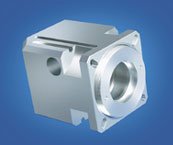Turned parts made of aluminium
PROTEC GMBH Zerspanungstechnik
77716-D Haslach im Kinzigtal
12 Schleifmattstr.
+49 7832 7090
+49 7832 70950
Turned parts made of aluminium
Anfrage an Anbieter senden
-
Material Selection:
- Choose the right alloy of aluminum for your application. Common aluminum alloys used in machining include 6061, 7075, and 2024. Each alloy has different properties, such as machinability, strength, and corrosion resistance.
-
Tool Selection:
- Select appropriate cutting tools for aluminum machining. Carbide inserts are commonly used for aluminum due to their hardness and wear resistance. Consider coatings like TiN or TiAlN to enhance tool life.
-
Cutting Speeds and Feeds:
- Aluminum is typically machined at higher cutting speeds compared to other metals. Adjust cutting speeds and feeds based on the specific aluminum alloy and the size and type of the turning tool. High speeds help prevent built-up edge and improve surface finish.
-
Coolant and Lubrication:
- While aluminum machining generates less heat than some other metals, using a coolant or lubricant can still be beneficial. Coolants aid in chip evacuation, reduce heat, and extend tool life. Consider water-soluble coolants for aluminum.
-
Workholding:
- Secure the aluminum workpiece using appropriate workholding methods. Soft jaws or custom fixtures may be used to prevent distortion or damage to the workpiece during machining.
-
Chip Control:
- Proper chip control is important to prevent chip entanglement and ensure a clean machining process. Adequate chip evacuation helps avoid re-cutting of chips, leading to improved surface finish.
-
Tool Path Optimization:
- Optimize tool paths to minimize tool changes, reduce cycle times, and achieve a smooth surface finish. Efficient programming can help in minimizing tool wear and maximizing machine productivity.
-
Surface Finish Considerations:
- Pay attention to the desired surface finish of the aluminum part. Adjust cutting parameters and tool selection to achieve the required surface quality. Post-machining processes like polishing may be required for specific applications.
-
CNC Programming:
- Develop CNC programs with precision and accuracy. Consider factors such as toolpath optimization, tool changes, and tool offsets. Thoroughly simulate and test the program before running it on the CNC machine.
-
Quality Control:
- Implement quality control measures to inspect critical dimensions and tolerances. Regularly check the machined parts to ensure they meet specifications.
-
Safety Precautions:
- Follow safety guidelines when operating CNC turning machines. Wear appropriate personal protective equipment (PPE) and be aware of the specific safety considerations associated with machining aluminum, such as the potential for sharp chips.
Turning
Gridding
Milling



